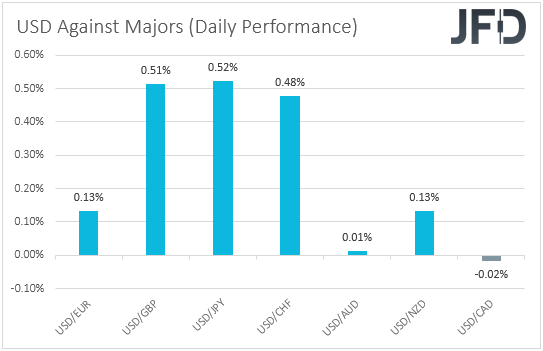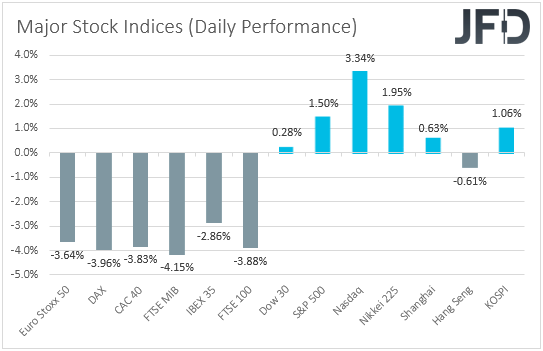Did Russian drones hit NATO territory? Romania president elucidates.
By Joanne Cassar / 07. Sep 2025
read moreWall Street rebounded yesterday, with the increase in appetite rolling into the Asian session today. The US and other Western nations decided to step up attempts against Russia’s business ability by imposing fresh and stricter sanctions. However, in our view, it is too early to assume that the sanctions will force Russia to back down or that any other nation will not get involved.
The US dollar continued trading higher against most of the other major currencies on Thursday and during the Asian morning Friday, with the main losers being JPY, GBP, and CHF. The only currencies against which the greenback did not eke out any gains and instead was found virtually unchanged are AUD and CAD.

Although the dollar kept marching north, the fact that the main losers were the safe-havens yen and franc suggests that the financial world may have turned to a risk-on mode at some point. Indeed, although EU shares closed in negative territory due to Russia’s invasion in Ukraine intensifying investors' flight to safety, Wall Street rebounded, with NASDAQ gaining the most.
Appetite stayed relatively supported during the Asian session today as well.

For another day, investors’ gaze stayed locked on developments surrounding the Russia-Ukraine conflict, and what may have prompted them to add back some risk to their portfolios may have been the decision of the US and other Western nations to redouble their efforts to crimp Russia’s ability to do business, with sanctions including freezing bank assets and cutting off state-owned enterprises.
Maybe, this sparked hopes that the conflict could be resolved without any other nation getting involved. US President Biden himself has repeatedly noted these days that the US would not engage in war with Russia. Yes, NATO members agree that an attack against one of them is considered an attack against all of them, but Ukraine is not a NATO member yet, and thus those protections do not apply.
Having said all that, though, it is too early to assume that the sanctions will force Russia to back down or that any other nation will not get involved. Thus, we prefer to treat yesterday’s recovery in risk assets as a corrective rebound, and we see decent chances for another leg south. Besides equities and other traditional risk-linked currencies, due to the geographical location of the conflict, we believe that the euro and the pound could suffer additional losses as well. At the same, safe havens, like the yen and franc, could come under renewed selling interest.
The only major risk-linked currency which could experience limited losses may be the Canadian dollar, and this is because the conflict is driving oil prices up due to fears of supply disruptions. Let’s not forget that Canada is the fifth largest oil-producing nation globally, while it holds sixth place in terms of exports.s
Now, in terms of monetary policy, some may, at first glance, think that the conflict could translate into a less hawkish narrative by major central banks. However, we believe that it may be the opposite. Surging oil prices to levels last seen in July 2014 could mean higher inflation in the months to come, which may require an even more aggressive tightening.
Thus, we stick to our guns that even if the geopolitical tensions ease sooner than expected, expectations over faster rate increases around the globe could keep a lid on any relief bounce. We believe that the path of least resistance will stay to the downside even when the Russia-Ukraine conflict ends.
The Euro Stoxx 50 opened with a negative gap yesterday but hit support slightly above the 3740 zone, marked by the inside swing high of Mar. 3, and then it rebounded. However, it is still trading below the upside support line drawn from the low of May 15 and also below the downside line taken from the high of Jan. 5. Thus, we still see a negative near-term picture.
Even if the rebound continues for a while more, we expect the bears to retake charge from somewhere below the 4060 barrier, marked by Wednesday’s peak. This could result in another tumble near the 3740 zone, the break of which would confirm a forthcoming lower low and may extend the latest short-term downtrend to the low of Feb. 26, at 3620.
On the upside, we would like to see a clear rebound back above the 4240 zone, marked by the high of Feb. 10, before assuming that the bulls are back in complete control. This could confirm the break back above the aforementioned diagonal lines and the main initially target the peak of Jan. 20, at 4303. Another break above that level could aim for the peak of Nov. 18 at 4415.
If participants are not willing to stop there, by breaking higher, they will enter territories last tested in December 2017. The following territories to consider as resistance may be the 4500 and 4600 areas.
EUR/JPY rebounded as well, after hitting support at 127.90. That said, the recovery was stopped by the 129.93 level, still below the downside resistance line drawn from the peak of Feb. 10. As long as the rate continues to print lower highs and lower lows below that line, we will stay negative regarding the short-term picture of this pair.
A clear break below 128.87 may confirm that the current rebound is over and that the bears are back in full control. We could then see another round of selling towards the 127.90 barrier, the break of which could aim for the 127.50 level, marked by the low of Dec. 12. If that barrier cannot hold either, then we could experience larger declines, perhaps towards the 126.65 zone, marked by the low of Feb. 10, 2021.
On the upside, we would like to see a clear break above 130.75 before we start examining the case of a bullish reversal. This rate would not only be well above the pre-discussed downside line, but it will also confirm a forthcoming higher high. The next resistance may be the peak of Feb. 18, at 131.12, the break of which could pave the way towards the high of Feb. 16, at 131.90, or the high of Feb. 11, at 132.30.
Another break, above 132.30, could see scope for extensions towards the 133.15 zone, marked by the high of Feb. 10.
We believe that market attention will stay locked on developments surrounding the Russia-Ukraine conflict for another day. However, there are some data on today’s agenda we need to mention, and those are the US durable goods orders for January, the personal income and spending, and well as the core PCE index for the same month.
We also have two ECB officials speaking today, and those are President Christine Lagarde and Supervisory Board member Elizabeth McCaul.
By Joanne Cassar / 04. Sep 2025
read more